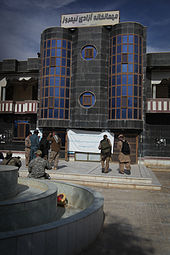Zaranj
[4] It is the capital of Nimruz Province and is linked by highways with Lashkargah and Kandahar to the east, Farah to the north and the Iranian city of Zabol to the west.The history of Zaranj dates back over 2,500 years and Ya'qub ibn al-Layth al-Saffar, founder of the Saffarid dynasty, was born in this old civilization.[11] After the abandonment of that city, its name, Zarang or Zaranj in later Perso-Arabic orthography, was transferred to the subsequent administrative centers of the region, which itself came to be known as Sakastān, then Sijistan[12] and finally Sistān.[13] According to the Arab geographers, prior to medieval Zaranj, the capital of Sistan was located at Ram Shahristan (Abar shariyar).[16] In the 9th century Zaranj was the capital of the Saffarid dynasty, whose founder was the local coppersmith turned warlord, Ya'qub ibn al-Layth al-Saffar.A new highway called Route 606 was built between Zaranj and Delaram in Farah province by the Indian Government's Border Roads Organization at a cost of about US$136 million to open up a link between the deep sea port at Chabahar in Iran to Afghanistan's main ring road highway system which connects Kabul, Kandahar, Herat, Mazar-i-Sharif and Kunduz."Completion of the road reflects the determination of both India and Afghanistan that nothing can prevent or hinder collaboration between the two countries," Mukherjee said at a function to mark this handover.[citation needed] The province has been one of the 7 (Nimruz, Helmand, Kandahar, Uruzgan, Ghazni, Paktika and Zabul) where the Taliban have been recently regrouping.Newcomers buy kebabs from street vendors, peruse shops and sit around plastic tables, eager to learn more about the grueling journey ahead".[26] According to the Ministry of Rural Rehabilitation and Development (MRRD) along with UNHCR and Central Statistics Office (CSO) of Afghanistan, the population of Zaranj was around 49,851 in 2004.

AfghanistanProvinceNimruz ProvinceZaranj DistrictTime zonePersianPashtoBalochiLashkargahKandaharIranianborder crossingAfghanistan–Iran borderCentral AsiaEast AsiaSouth AsiaMiddle EastZaranj AirportYa'qub ibn al-Layth al-SaffarSaffarid dynastyHistory of AfghanistanOld PersianDrangianaAchaemenidDahan-e GholamanSistānRam ShahristanPeutinger Maplate AntiquityMahmud of GhazniJami al-TawarikhKhurāsānNestorian ChristianwarlordGhaznavidsGhoridsTrimuridsSafavidsSamanidsNasridMihrabānidAfghanHotaki dynastyNader ShahKhorasanKhanate of KalatFarah-Chakansur ProvinceRoute 606DelaramIndian GovernmentBorder Roads OrganizationChabaharMazar-i-SharifKunduzPranab MukherjeeHamid KarzaiRangeen Dadfar SpantaNimruzHelmandUruzganGhazniPaktikaAfghan Border PoliceU.S. MarinesInternational Security Assistance ForceAfghan governmentAfghan militaryAfghan National Police3rd Marine Aircraft WingForward Operating Base DelaramV-22 Osprey3rd Battalion 4th MarineshelipadsCapture of ZaranjTalibanadvanceswithdrawalBattle of LashkargahNew York Timeskebabshot desert climateKöppen climate classificationSnowfallprecipitationrelative humidityDemographics of AfghanistanMinistry of Rural Rehabilitation and DevelopmentBalochPashtunSistanAmr ibn al-LaythAl-Layth ibn Ali ibn al-LaythSaffarid amirateAl-Mu'addal ibn al-LaythSaffaridZaranjTransport in Afghanistantwo-lane roadFarah ProvinceKandahar–Herat HighwayHajigak mining concessionPort of ChabaharList of cities in AfghanistanIslam QalaEncyclopædia IranicaAlexander the GreatCurtius RufusAmmianus MarcellinusValerius FlaccusPercy SykesItamar RabinovichThe New York TimesNational Oceanic and Atmospheric AdministrationThe HinduLe Strange, GuyYouTubeWayback MachineCapitalDistrictsChahar Burjak DistrictChakhansurKhash RodIstowayDasht-e KhashDasht-e MargoHamun Lake